Evaluating Quantitative Research Studies
VerifiedAdded on 2020/06/04
|15
|6456
|21
AI Summary
This assignment requires students to critically evaluate quantitative research studies using the EPHPP (Evidence-Based Public Health) Qualitative Assessment Tool. The tool, adapted from the CASP Randomised Controlled Trial Checklist, guides students in assessing various aspects of the research design, methodology, and results. Students must complete a checklist for each study provided, ensuring they understand the criteria for methodological rigor and can apply them to real-world examples.
Contribute Materials
Your contribution can guide someone’s learning journey. Share your
documents today.
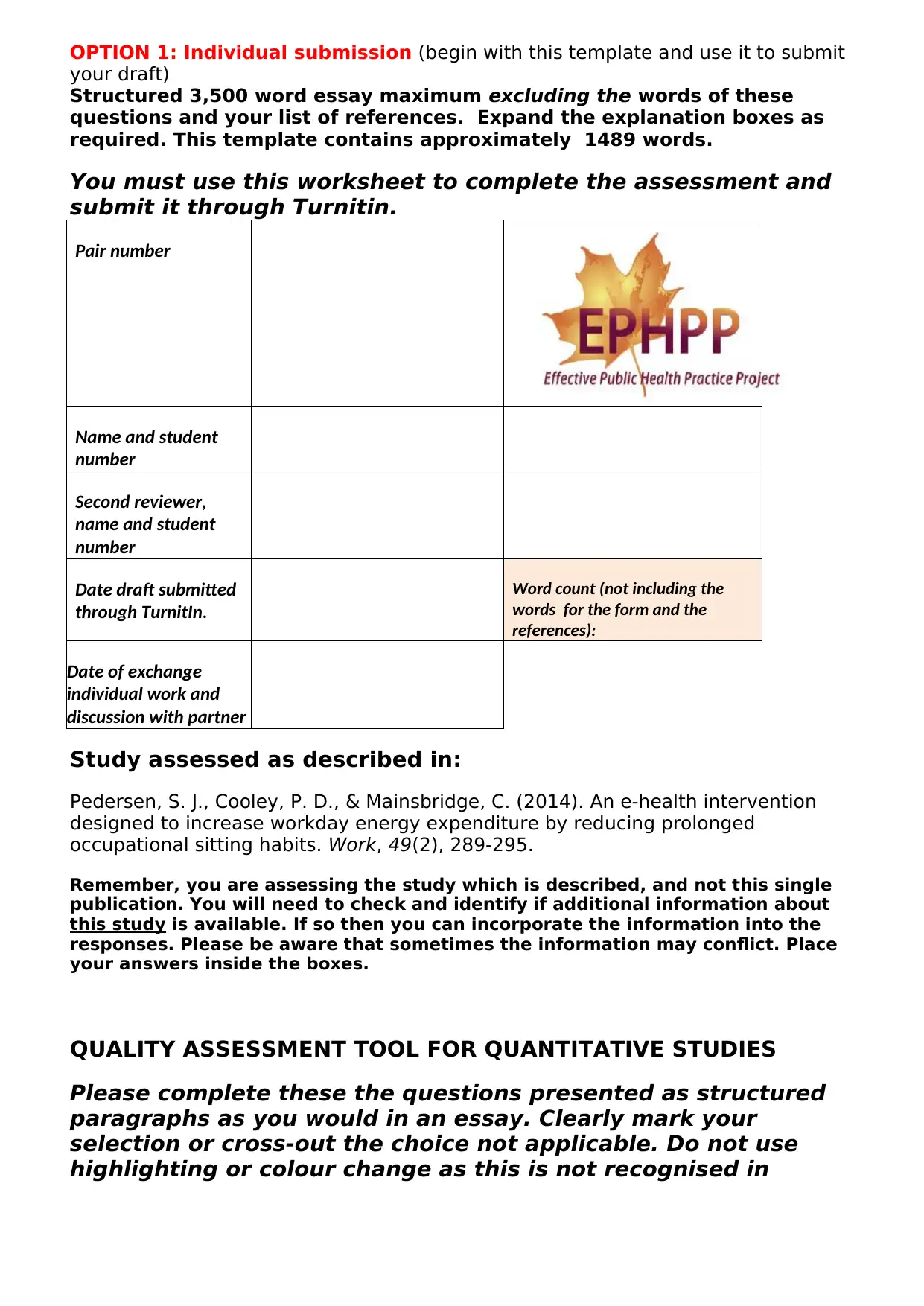
OPTION 1: Individual submission (begin with this template and use it to submit
your draft)
Structured 3,500 word essay maximum excluding the words of these
questions and your list of references. Expand the explanation boxes as
required. This template contains approximately 1489 words.
You must use this worksheet to complete the assessment and
submit it through Turnitin.
Pair number
Name and student
number
Second reviewer,
name and student
number
Date draft submitted
through TurnitIn.
Word count (not including the
words for the form and the
references):
Date of exchange
individual work and
discussion with partner
Study assessed as described in:
Pedersen, S. J., Cooley, P. D., & Mainsbridge, C. (2014). An e-health intervention
designed to increase workday energy expenditure by reducing prolonged
occupational sitting habits. Work, 49(2), 289-295.
Remember, you are assessing the study which is described, and not this single
publication. You will need to check and identify if additional information about
this study is available. If so then you can incorporate the information into the
responses. Please be aware that sometimes the information may conflict. Place
your answers inside the boxes.
QUALITY ASSESSMENT TOOL FOR QUANTITATIVE STUDIES
Please complete these the questions presented as structured
paragraphs as you would in an essay. Clearly mark your
selection or cross-out the choice not applicable. Do not use
highlighting or colour change as this is not recognised in
your draft)
Structured 3,500 word essay maximum excluding the words of these
questions and your list of references. Expand the explanation boxes as
required. This template contains approximately 1489 words.
You must use this worksheet to complete the assessment and
submit it through Turnitin.
Pair number
Name and student
number
Second reviewer,
name and student
number
Date draft submitted
through TurnitIn.
Word count (not including the
words for the form and the
references):
Date of exchange
individual work and
discussion with partner
Study assessed as described in:
Pedersen, S. J., Cooley, P. D., & Mainsbridge, C. (2014). An e-health intervention
designed to increase workday energy expenditure by reducing prolonged
occupational sitting habits. Work, 49(2), 289-295.
Remember, you are assessing the study which is described, and not this single
publication. You will need to check and identify if additional information about
this study is available. If so then you can incorporate the information into the
responses. Please be aware that sometimes the information may conflict. Place
your answers inside the boxes.
QUALITY ASSESSMENT TOOL FOR QUANTITATIVE STUDIES
Please complete these the questions presented as structured
paragraphs as you would in an essay. Clearly mark your
selection or cross-out the choice not applicable. Do not use
highlighting or colour change as this is not recognised in
Secure Best Marks with AI Grader
Need help grading? Try our AI Grader for instant feedback on your assignments.

Turnitin. Demonstrate your knowledge of epidemiological
principles within each section and support your statements.
principles within each section and support your statements.
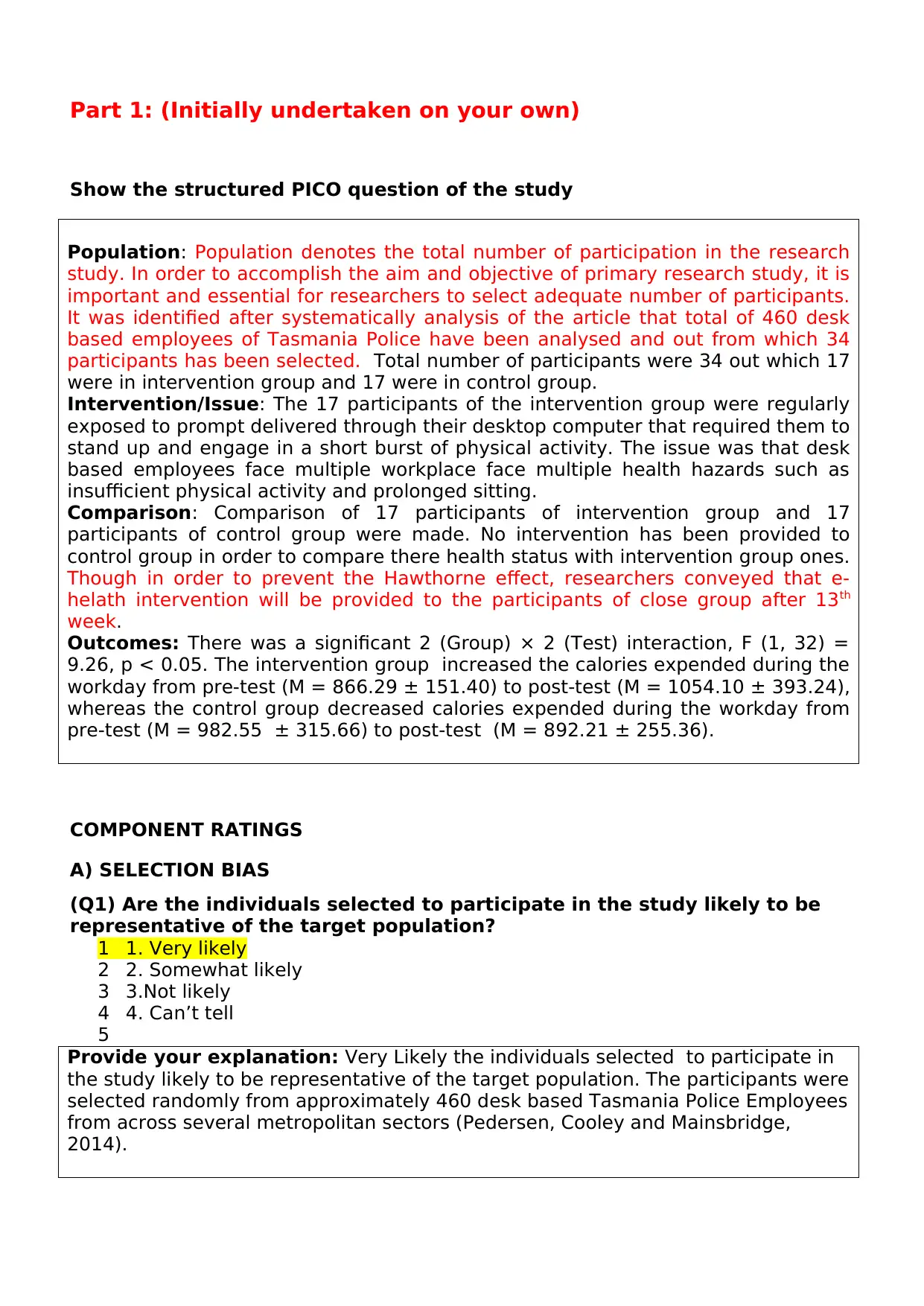
Part 1: (Initially undertaken on your own)
Show the structured PICO question of the study
Population: Population denotes the total number of participation in the research
study. In order to accomplish the aim and objective of primary research study, it is
important and essential for researchers to select adequate number of participants.
It was identified after systematically analysis of the article that total of 460 desk
based employees of Tasmania Police have been analysed and out from which 34
participants has been selected. Total number of participants were 34 out which 17
were in intervention group and 17 were in control group.
Intervention/Issue: The 17 participants of the intervention group were regularly
exposed to prompt delivered through their desktop computer that required them to
stand up and engage in a short burst of physical activity. The issue was that desk
based employees face multiple workplace face multiple health hazards such as
insufficient physical activity and prolonged sitting.
Comparison: Comparison of 17 participants of intervention group and 17
participants of control group were made. No intervention has been provided to
control group in order to compare there health status with intervention group ones.
Though in order to prevent the Hawthorne effect, researchers conveyed that e-
helath intervention will be provided to the participants of close group after 13th
week.
Outcomes: There was a significant 2 (Group) × 2 (Test) interaction, F (1, 32) =
9.26, p < 0.05. The intervention group increased the calories expended during the
workday from pre-test (M = 866.29 ± 151.40) to post-test (M = 1054.10 ± 393.24),
whereas the control group decreased calories expended during the workday from
pre-test (M = 982.55 ± 315.66) to post-test (M = 892.21 ± 255.36).
COMPONENT RATINGS
A) SELECTION BIAS
(Q1) Are the individuals selected to participate in the study likely to be
representative of the target population?
1 1. Very likely
2 2. Somewhat likely
3 3.Not likely
4 4. Can’t tell
5
Provide your explanation: Very Likely the individuals selected to participate in
the study likely to be representative of the target population. The participants were
selected randomly from approximately 460 desk based Tasmania Police Employees
from across several metropolitan sectors (Pedersen, Cooley and Mainsbridge,
2014).
Show the structured PICO question of the study
Population: Population denotes the total number of participation in the research
study. In order to accomplish the aim and objective of primary research study, it is
important and essential for researchers to select adequate number of participants.
It was identified after systematically analysis of the article that total of 460 desk
based employees of Tasmania Police have been analysed and out from which 34
participants has been selected. Total number of participants were 34 out which 17
were in intervention group and 17 were in control group.
Intervention/Issue: The 17 participants of the intervention group were regularly
exposed to prompt delivered through their desktop computer that required them to
stand up and engage in a short burst of physical activity. The issue was that desk
based employees face multiple workplace face multiple health hazards such as
insufficient physical activity and prolonged sitting.
Comparison: Comparison of 17 participants of intervention group and 17
participants of control group were made. No intervention has been provided to
control group in order to compare there health status with intervention group ones.
Though in order to prevent the Hawthorne effect, researchers conveyed that e-
helath intervention will be provided to the participants of close group after 13th
week.
Outcomes: There was a significant 2 (Group) × 2 (Test) interaction, F (1, 32) =
9.26, p < 0.05. The intervention group increased the calories expended during the
workday from pre-test (M = 866.29 ± 151.40) to post-test (M = 1054.10 ± 393.24),
whereas the control group decreased calories expended during the workday from
pre-test (M = 982.55 ± 315.66) to post-test (M = 892.21 ± 255.36).
COMPONENT RATINGS
A) SELECTION BIAS
(Q1) Are the individuals selected to participate in the study likely to be
representative of the target population?
1 1. Very likely
2 2. Somewhat likely
3 3.Not likely
4 4. Can’t tell
5
Provide your explanation: Very Likely the individuals selected to participate in
the study likely to be representative of the target population. The participants were
selected randomly from approximately 460 desk based Tasmania Police Employees
from across several metropolitan sectors (Pedersen, Cooley and Mainsbridge,
2014).
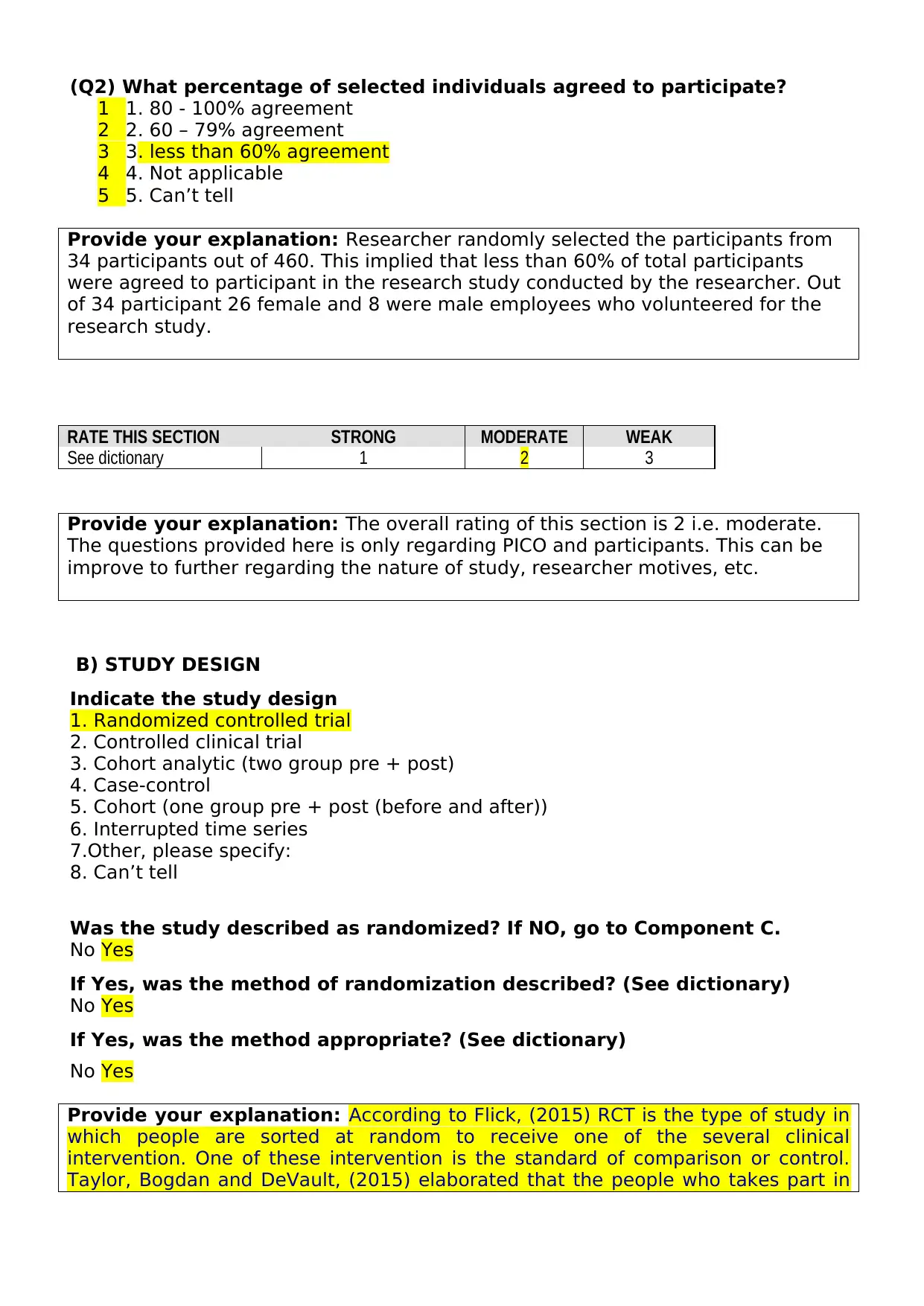
(Q2) What percentage of selected individuals agreed to participate?
1 1. 80 - 100% agreement
2 2. 60 – 79% agreement
3 3. less than 60% agreement
4 4. Not applicable
5 5. Can’t tell
Provide your explanation: Researcher randomly selected the participants from
34 participants out of 460. This implied that less than 60% of total participants
were agreed to participant in the research study conducted by the researcher. Out
of 34 participant 26 female and 8 were male employees who volunteered for the
research study.
RATE THIS SECTION STRONG MODERATE WEAK
See dictionary 1 2 3
Provide your explanation: The overall rating of this section is 2 i.e. moderate.
The questions provided here is only regarding PICO and participants. This can be
improve to further regarding the nature of study, researcher motives, etc.
B) STUDY DESIGN
Indicate the study design
1. Randomized controlled trial
2. Controlled clinical trial
3. Cohort analytic (two group pre + post)
4. Case-control
5. Cohort (one group pre + post (before and after))
6. Interrupted time series
7.Other, please specify:
8. Can’t tell
Was the study described as randomized? If NO, go to Component C.
No Yes
If Yes, was the method of randomization described? (See dictionary)
No Yes
If Yes, was the method appropriate? (See dictionary)
No Yes
Provide your explanation: According to Flick, (2015) RCT is the type of study in
which people are sorted at random to receive one of the several clinical
intervention. One of these intervention is the standard of comparison or control.
Taylor, Bogdan and DeVault, (2015) elaborated that the people who takes part in
1 1. 80 - 100% agreement
2 2. 60 – 79% agreement
3 3. less than 60% agreement
4 4. Not applicable
5 5. Can’t tell
Provide your explanation: Researcher randomly selected the participants from
34 participants out of 460. This implied that less than 60% of total participants
were agreed to participant in the research study conducted by the researcher. Out
of 34 participant 26 female and 8 were male employees who volunteered for the
research study.
RATE THIS SECTION STRONG MODERATE WEAK
See dictionary 1 2 3
Provide your explanation: The overall rating of this section is 2 i.e. moderate.
The questions provided here is only regarding PICO and participants. This can be
improve to further regarding the nature of study, researcher motives, etc.
B) STUDY DESIGN
Indicate the study design
1. Randomized controlled trial
2. Controlled clinical trial
3. Cohort analytic (two group pre + post)
4. Case-control
5. Cohort (one group pre + post (before and after))
6. Interrupted time series
7.Other, please specify:
8. Can’t tell
Was the study described as randomized? If NO, go to Component C.
No Yes
If Yes, was the method of randomization described? (See dictionary)
No Yes
If Yes, was the method appropriate? (See dictionary)
No Yes
Provide your explanation: According to Flick, (2015) RCT is the type of study in
which people are sorted at random to receive one of the several clinical
intervention. One of these intervention is the standard of comparison or control.
Taylor, Bogdan and DeVault, (2015) elaborated that the people who takes part in
Secure Best Marks with AI Grader
Need help grading? Try our AI Grader for instant feedback on your assignments.
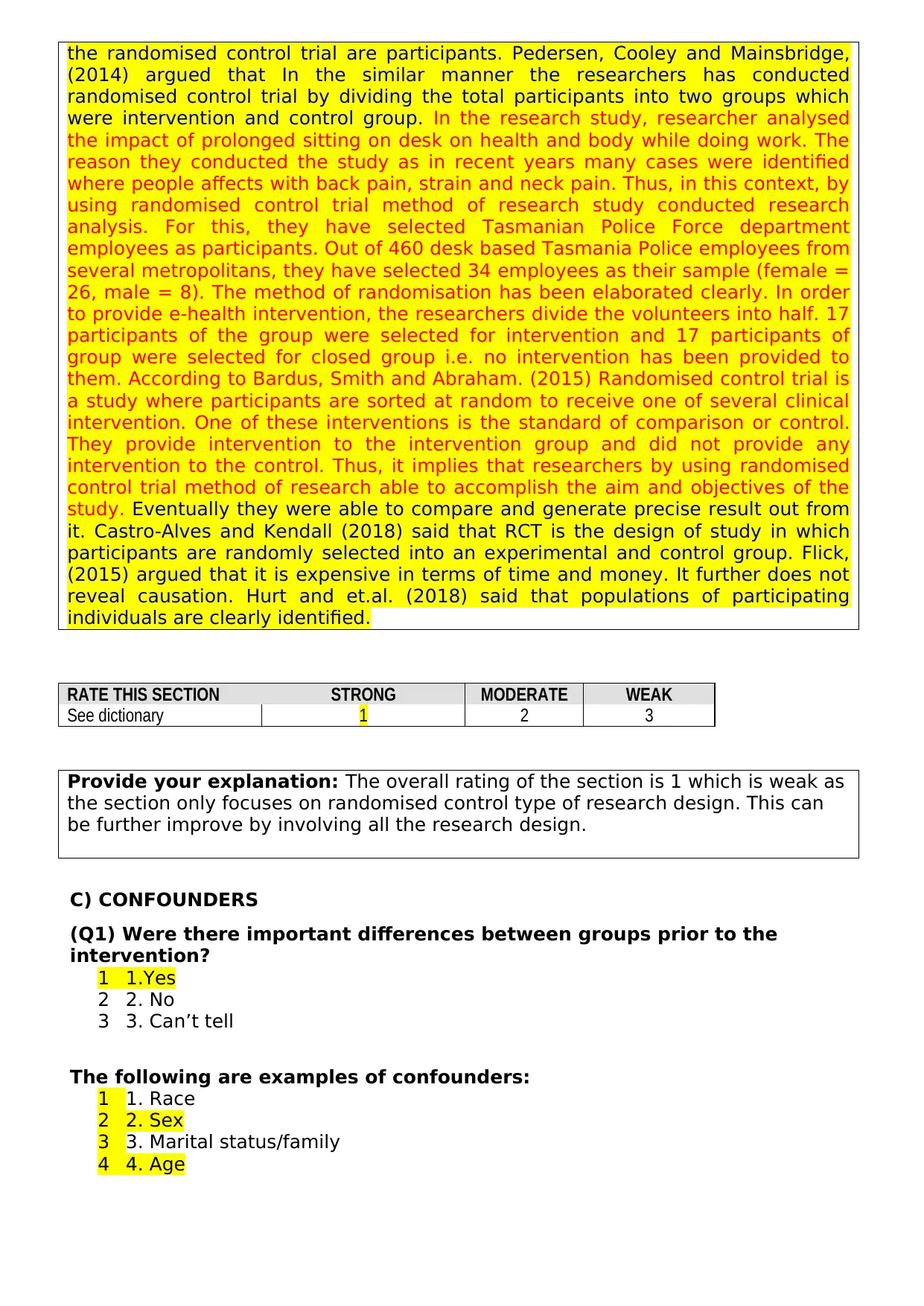
the randomised control trial are participants. Pedersen, Cooley and Mainsbridge,
(2014) argued that In the similar manner the researchers has conducted
randomised control trial by dividing the total participants into two groups which
were intervention and control group. In the research study, researcher analysed
the impact of prolonged sitting on desk on health and body while doing work. The
reason they conducted the study as in recent years many cases were identified
where people affects with back pain, strain and neck pain. Thus, in this context, by
using randomised control trial method of research study conducted research
analysis. For this, they have selected Tasmanian Police Force department
employees as participants. Out of 460 desk based Tasmania Police employees from
several metropolitans, they have selected 34 employees as their sample (female =
26, male = 8). The method of randomisation has been elaborated clearly. In order
to provide e-health intervention, the researchers divide the volunteers into half. 17
participants of the group were selected for intervention and 17 participants of
group were selected for closed group i.e. no intervention has been provided to
them. According to Bardus, Smith and Abraham. (2015) Randomised control trial is
a study where participants are sorted at random to receive one of several clinical
intervention. One of these interventions is the standard of comparison or control.
They provide intervention to the intervention group and did not provide any
intervention to the control. Thus, it implies that researchers by using randomised
control trial method of research able to accomplish the aim and objectives of the
study. Eventually they were able to compare and generate precise result out from
it. Castro-Alves and Kendall (2018) said that RCT is the design of study in which
participants are randomly selected into an experimental and control group. Flick,
(2015) argued that it is expensive in terms of time and money. It further does not
reveal causation. Hurt and et.al. (2018) said that populations of participating
individuals are clearly identified.
RATE THIS SECTION STRONG MODERATE WEAK
See dictionary 1 2 3
Provide your explanation: The overall rating of the section is 1 which is weak as
the section only focuses on randomised control type of research design. This can
be further improve by involving all the research design.
C) CONFOUNDERS
(Q1) Were there important differences between groups prior to the
intervention?
1 1.Yes
2 2. No
3 3. Can’t tell
The following are examples of confounders:
1 1. Race
2 2. Sex
3 3. Marital status/family
4 4. Age
(2014) argued that In the similar manner the researchers has conducted
randomised control trial by dividing the total participants into two groups which
were intervention and control group. In the research study, researcher analysed
the impact of prolonged sitting on desk on health and body while doing work. The
reason they conducted the study as in recent years many cases were identified
where people affects with back pain, strain and neck pain. Thus, in this context, by
using randomised control trial method of research study conducted research
analysis. For this, they have selected Tasmanian Police Force department
employees as participants. Out of 460 desk based Tasmania Police employees from
several metropolitans, they have selected 34 employees as their sample (female =
26, male = 8). The method of randomisation has been elaborated clearly. In order
to provide e-health intervention, the researchers divide the volunteers into half. 17
participants of the group were selected for intervention and 17 participants of
group were selected for closed group i.e. no intervention has been provided to
them. According to Bardus, Smith and Abraham. (2015) Randomised control trial is
a study where participants are sorted at random to receive one of several clinical
intervention. One of these interventions is the standard of comparison or control.
They provide intervention to the intervention group and did not provide any
intervention to the control. Thus, it implies that researchers by using randomised
control trial method of research able to accomplish the aim and objectives of the
study. Eventually they were able to compare and generate precise result out from
it. Castro-Alves and Kendall (2018) said that RCT is the design of study in which
participants are randomly selected into an experimental and control group. Flick,
(2015) argued that it is expensive in terms of time and money. It further does not
reveal causation. Hurt and et.al. (2018) said that populations of participating
individuals are clearly identified.
RATE THIS SECTION STRONG MODERATE WEAK
See dictionary 1 2 3
Provide your explanation: The overall rating of the section is 1 which is weak as
the section only focuses on randomised control type of research design. This can
be further improve by involving all the research design.
C) CONFOUNDERS
(Q1) Were there important differences between groups prior to the
intervention?
1 1.Yes
2 2. No
3 3. Can’t tell
The following are examples of confounders:
1 1. Race
2 2. Sex
3 3. Marital status/family
4 4. Age
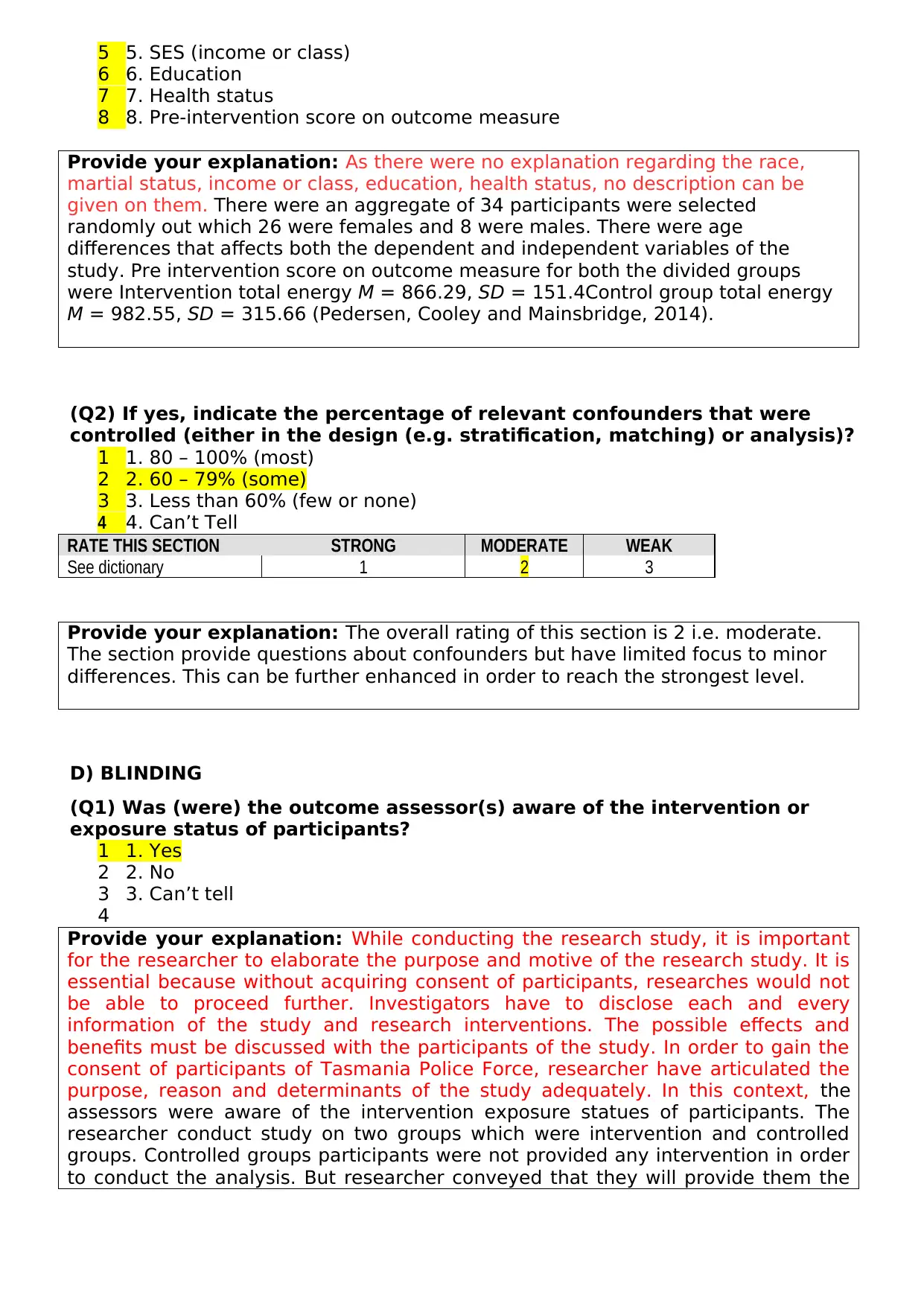
5 5. SES (income or class)
6 6. Education
7 7. Health status
8 8. Pre-intervention score on outcome measure
Provide your explanation: As there were no explanation regarding the race,
martial status, income or class, education, health status, no description can be
given on them. There were an aggregate of 34 participants were selected
randomly out which 26 were females and 8 were males. There were age
differences that affects both the dependent and independent variables of the
study. Pre intervention score on outcome measure for both the divided groups
were Intervention total energy M = 866.29, SD = 151.4Control group total energy
M = 982.55, SD = 315.66 (Pedersen, Cooley and Mainsbridge, 2014).
(Q2) If yes, indicate the percentage of relevant confounders that were
controlled (either in the design (e.g. stratification, matching) or analysis)?
1 1. 80 – 100% (most)
2 2. 60 – 79% (some)
3 3. Less than 60% (few or none)
4 4. Can’t Tell
RATE THIS SECTION STRONG MODERATE WEAK
See dictionary 1 2 3
Provide your explanation: The overall rating of this section is 2 i.e. moderate.
The section provide questions about confounders but have limited focus to minor
differences. This can be further enhanced in order to reach the strongest level.
D) BLINDING
(Q1) Was (were) the outcome assessor(s) aware of the intervention or
exposure status of participants?
1 1. Yes
2 2. No
3 3. Can’t tell
4
Provide your explanation: While conducting the research study, it is important
for the researcher to elaborate the purpose and motive of the research study. It is
essential because without acquiring consent of participants, researches would not
be able to proceed further. Investigators have to disclose each and every
information of the study and research interventions. The possible effects and
benefits must be discussed with the participants of the study. In order to gain the
consent of participants of Tasmania Police Force, researcher have articulated the
purpose, reason and determinants of the study adequately. In this context, the
assessors were aware of the intervention exposure statues of participants. The
researcher conduct study on two groups which were intervention and controlled
groups. Controlled groups participants were not provided any intervention in order
to conduct the analysis. But researcher conveyed that they will provide them the
6 6. Education
7 7. Health status
8 8. Pre-intervention score on outcome measure
Provide your explanation: As there were no explanation regarding the race,
martial status, income or class, education, health status, no description can be
given on them. There were an aggregate of 34 participants were selected
randomly out which 26 were females and 8 were males. There were age
differences that affects both the dependent and independent variables of the
study. Pre intervention score on outcome measure for both the divided groups
were Intervention total energy M = 866.29, SD = 151.4Control group total energy
M = 982.55, SD = 315.66 (Pedersen, Cooley and Mainsbridge, 2014).
(Q2) If yes, indicate the percentage of relevant confounders that were
controlled (either in the design (e.g. stratification, matching) or analysis)?
1 1. 80 – 100% (most)
2 2. 60 – 79% (some)
3 3. Less than 60% (few or none)
4 4. Can’t Tell
RATE THIS SECTION STRONG MODERATE WEAK
See dictionary 1 2 3
Provide your explanation: The overall rating of this section is 2 i.e. moderate.
The section provide questions about confounders but have limited focus to minor
differences. This can be further enhanced in order to reach the strongest level.
D) BLINDING
(Q1) Was (were) the outcome assessor(s) aware of the intervention or
exposure status of participants?
1 1. Yes
2 2. No
3 3. Can’t tell
4
Provide your explanation: While conducting the research study, it is important
for the researcher to elaborate the purpose and motive of the research study. It is
essential because without acquiring consent of participants, researches would not
be able to proceed further. Investigators have to disclose each and every
information of the study and research interventions. The possible effects and
benefits must be discussed with the participants of the study. In order to gain the
consent of participants of Tasmania Police Force, researcher have articulated the
purpose, reason and determinants of the study adequately. In this context, the
assessors were aware of the intervention exposure statues of participants. The
researcher conduct study on two groups which were intervention and controlled
groups. Controlled groups participants were not provided any intervention in order
to conduct the analysis. But researcher conveyed that they will provide them the
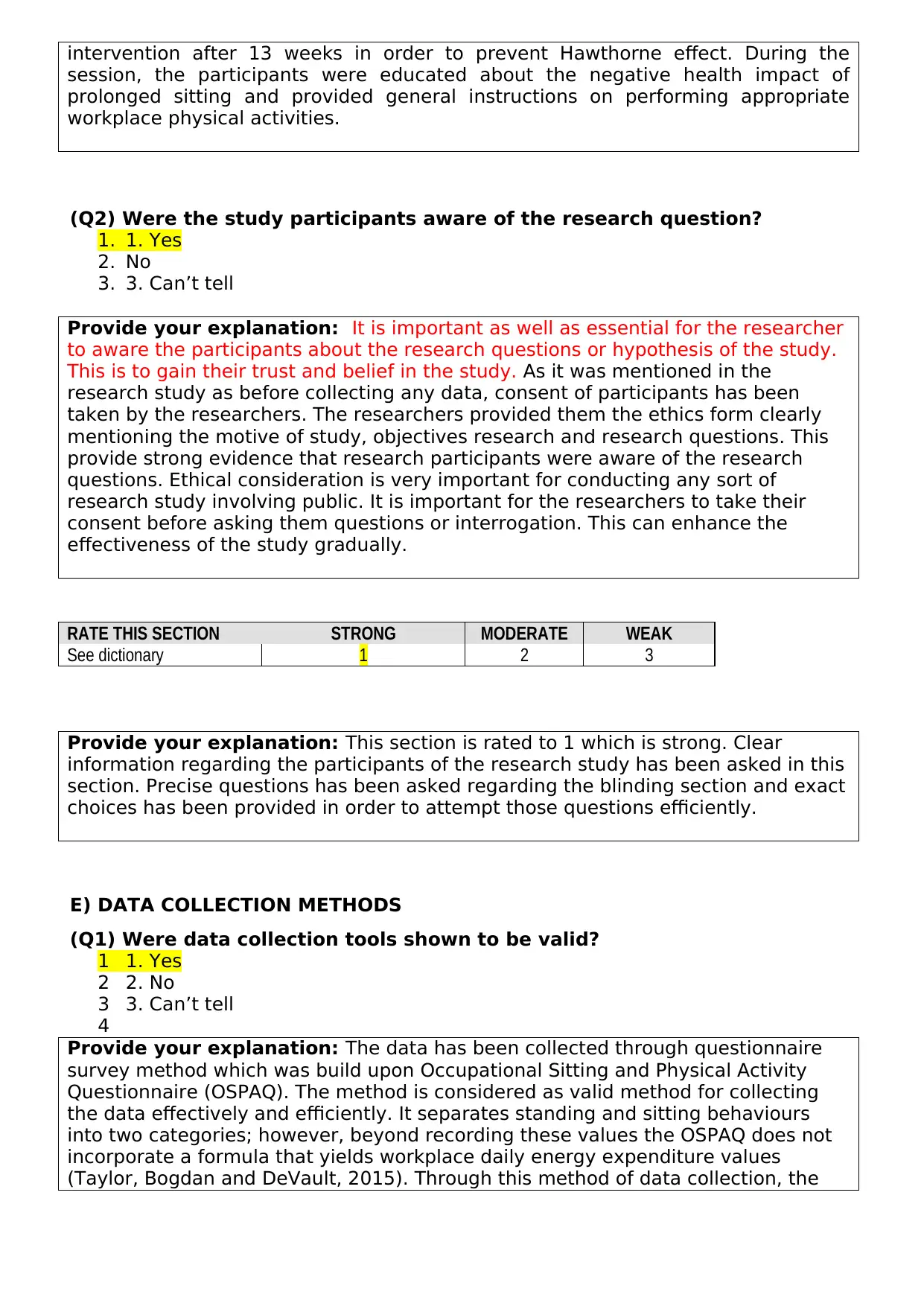
intervention after 13 weeks in order to prevent Hawthorne effect. During the
session, the participants were educated about the negative health impact of
prolonged sitting and provided general instructions on performing appropriate
workplace physical activities.
(Q2) Were the study participants aware of the research question?
1. 1. Yes
2. No
3. 3. Can’t tell
Provide your explanation: It is important as well as essential for the researcher
to aware the participants about the research questions or hypothesis of the study.
This is to gain their trust and belief in the study. As it was mentioned in the
research study as before collecting any data, consent of participants has been
taken by the researchers. The researchers provided them the ethics form clearly
mentioning the motive of study, objectives research and research questions. This
provide strong evidence that research participants were aware of the research
questions. Ethical consideration is very important for conducting any sort of
research study involving public. It is important for the researchers to take their
consent before asking them questions or interrogation. This can enhance the
effectiveness of the study gradually.
RATE THIS SECTION STRONG MODERATE WEAK
See dictionary 1 2 3
Provide your explanation: This section is rated to 1 which is strong. Clear
information regarding the participants of the research study has been asked in this
section. Precise questions has been asked regarding the blinding section and exact
choices has been provided in order to attempt those questions efficiently.
E) DATA COLLECTION METHODS
(Q1) Were data collection tools shown to be valid?
1 1. Yes
2 2. No
3 3. Can’t tell
4
Provide your explanation: The data has been collected through questionnaire
survey method which was build upon Occupational Sitting and Physical Activity
Questionnaire (OSPAQ). The method is considered as valid method for collecting
the data effectively and efficiently. It separates standing and sitting behaviours
into two categories; however, beyond recording these values the OSPAQ does not
incorporate a formula that yields workplace daily energy expenditure values
(Taylor, Bogdan and DeVault, 2015). Through this method of data collection, the
session, the participants were educated about the negative health impact of
prolonged sitting and provided general instructions on performing appropriate
workplace physical activities.
(Q2) Were the study participants aware of the research question?
1. 1. Yes
2. No
3. 3. Can’t tell
Provide your explanation: It is important as well as essential for the researcher
to aware the participants about the research questions or hypothesis of the study.
This is to gain their trust and belief in the study. As it was mentioned in the
research study as before collecting any data, consent of participants has been
taken by the researchers. The researchers provided them the ethics form clearly
mentioning the motive of study, objectives research and research questions. This
provide strong evidence that research participants were aware of the research
questions. Ethical consideration is very important for conducting any sort of
research study involving public. It is important for the researchers to take their
consent before asking them questions or interrogation. This can enhance the
effectiveness of the study gradually.
RATE THIS SECTION STRONG MODERATE WEAK
See dictionary 1 2 3
Provide your explanation: This section is rated to 1 which is strong. Clear
information regarding the participants of the research study has been asked in this
section. Precise questions has been asked regarding the blinding section and exact
choices has been provided in order to attempt those questions efficiently.
E) DATA COLLECTION METHODS
(Q1) Were data collection tools shown to be valid?
1 1. Yes
2 2. No
3 3. Can’t tell
4
Provide your explanation: The data has been collected through questionnaire
survey method which was build upon Occupational Sitting and Physical Activity
Questionnaire (OSPAQ). The method is considered as valid method for collecting
the data effectively and efficiently. It separates standing and sitting behaviours
into two categories; however, beyond recording these values the OSPAQ does not
incorporate a formula that yields workplace daily energy expenditure values
(Taylor, Bogdan and DeVault, 2015). Through this method of data collection, the
Paraphrase This Document
Need a fresh take? Get an instant paraphrase of this document with our AI Paraphraser
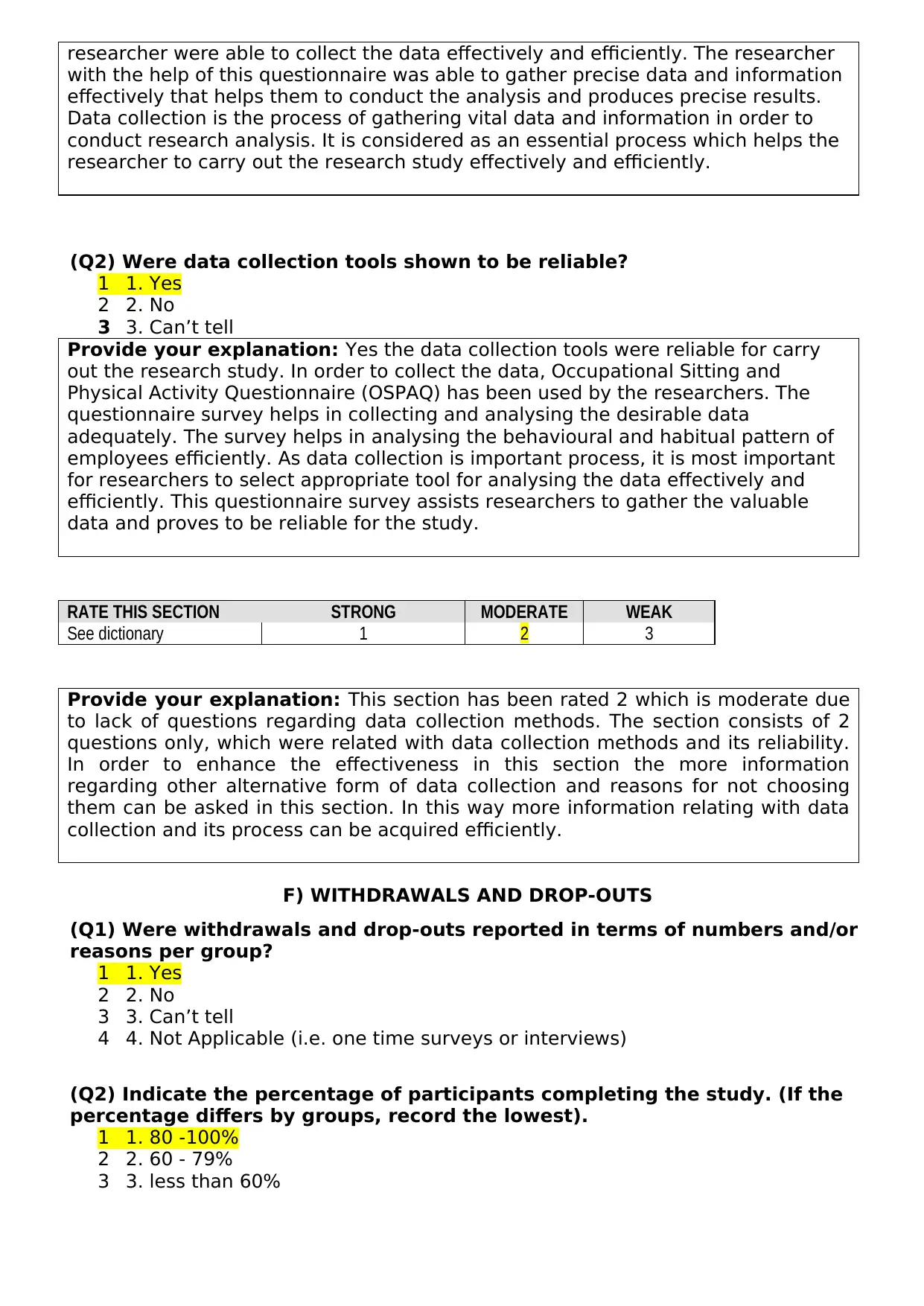
researcher were able to collect the data effectively and efficiently. The researcher
with the help of this questionnaire was able to gather precise data and information
effectively that helps them to conduct the analysis and produces precise results.
Data collection is the process of gathering vital data and information in order to
conduct research analysis. It is considered as an essential process which helps the
researcher to carry out the research study effectively and efficiently.
(Q2) Were data collection tools shown to be reliable?
1 1. Yes
2 2. No
3 3. Can’t tell
Provide your explanation: Yes the data collection tools were reliable for carry
out the research study. In order to collect the data, Occupational Sitting and
Physical Activity Questionnaire (OSPAQ) has been used by the researchers. The
questionnaire survey helps in collecting and analysing the desirable data
adequately. The survey helps in analysing the behavioural and habitual pattern of
employees efficiently. As data collection is important process, it is most important
for researchers to select appropriate tool for analysing the data effectively and
efficiently. This questionnaire survey assists researchers to gather the valuable
data and proves to be reliable for the study.
RATE THIS SECTION STRONG MODERATE WEAK
See dictionary 1 2 3
Provide your explanation: This section has been rated 2 which is moderate due
to lack of questions regarding data collection methods. The section consists of 2
questions only, which were related with data collection methods and its reliability.
In order to enhance the effectiveness in this section the more information
regarding other alternative form of data collection and reasons for not choosing
them can be asked in this section. In this way more information relating with data
collection and its process can be acquired efficiently.
F) WITHDRAWALS AND DROP-OUTS
(Q1) Were withdrawals and drop-outs reported in terms of numbers and/or
reasons per group?
1 1. Yes
2 2. No
3 3. Can’t tell
4 4. Not Applicable (i.e. one time surveys or interviews)
(Q2) Indicate the percentage of participants completing the study. (If the
percentage differs by groups, record the lowest).
1 1. 80 -100%
2 2. 60 - 79%
3 3. less than 60%
with the help of this questionnaire was able to gather precise data and information
effectively that helps them to conduct the analysis and produces precise results.
Data collection is the process of gathering vital data and information in order to
conduct research analysis. It is considered as an essential process which helps the
researcher to carry out the research study effectively and efficiently.
(Q2) Were data collection tools shown to be reliable?
1 1. Yes
2 2. No
3 3. Can’t tell
Provide your explanation: Yes the data collection tools were reliable for carry
out the research study. In order to collect the data, Occupational Sitting and
Physical Activity Questionnaire (OSPAQ) has been used by the researchers. The
questionnaire survey helps in collecting and analysing the desirable data
adequately. The survey helps in analysing the behavioural and habitual pattern of
employees efficiently. As data collection is important process, it is most important
for researchers to select appropriate tool for analysing the data effectively and
efficiently. This questionnaire survey assists researchers to gather the valuable
data and proves to be reliable for the study.
RATE THIS SECTION STRONG MODERATE WEAK
See dictionary 1 2 3
Provide your explanation: This section has been rated 2 which is moderate due
to lack of questions regarding data collection methods. The section consists of 2
questions only, which were related with data collection methods and its reliability.
In order to enhance the effectiveness in this section the more information
regarding other alternative form of data collection and reasons for not choosing
them can be asked in this section. In this way more information relating with data
collection and its process can be acquired efficiently.
F) WITHDRAWALS AND DROP-OUTS
(Q1) Were withdrawals and drop-outs reported in terms of numbers and/or
reasons per group?
1 1. Yes
2 2. No
3 3. Can’t tell
4 4. Not Applicable (i.e. one time surveys or interviews)
(Q2) Indicate the percentage of participants completing the study. (If the
percentage differs by groups, record the lowest).
1 1. 80 -100%
2 2. 60 - 79%
3 3. less than 60%
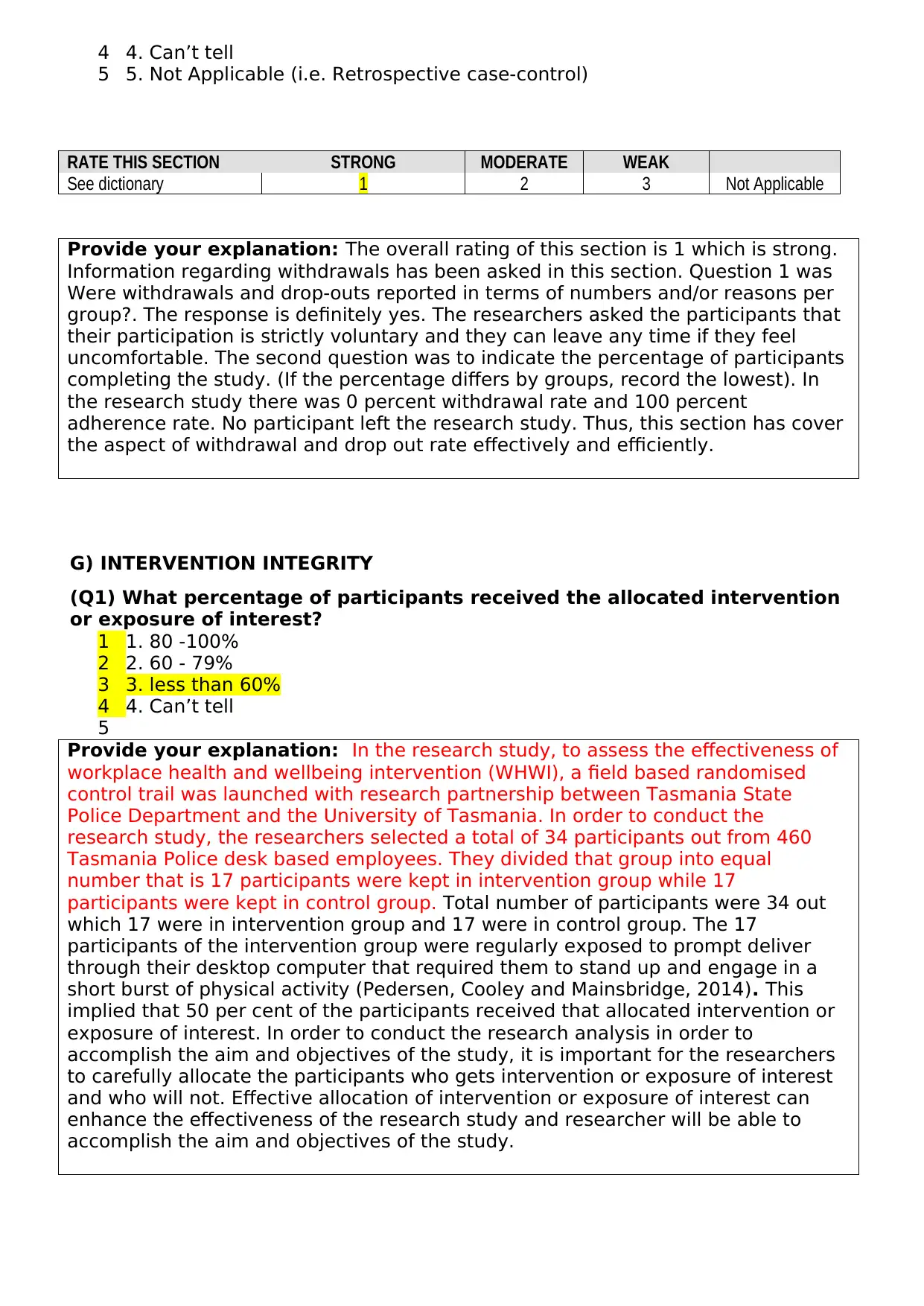
4 4. Can’t tell
5 5. Not Applicable (i.e. Retrospective case-control)
RATE THIS SECTION STRONG MODERATE WEAK
See dictionary 1 2 3 Not Applicable
Provide your explanation: The overall rating of this section is 1 which is strong.
Information regarding withdrawals has been asked in this section. Question 1 was
Were withdrawals and drop-outs reported in terms of numbers and/or reasons per
group?. The response is definitely yes. The researchers asked the participants that
their participation is strictly voluntary and they can leave any time if they feel
uncomfortable. The second question was to indicate the percentage of participants
completing the study. (If the percentage differs by groups, record the lowest). In
the research study there was 0 percent withdrawal rate and 100 percent
adherence rate. No participant left the research study. Thus, this section has cover
the aspect of withdrawal and drop out rate effectively and efficiently.
G) INTERVENTION INTEGRITY
(Q1) What percentage of participants received the allocated intervention
or exposure of interest?
1 1. 80 -100%
2 2. 60 - 79%
3 3. less than 60%
4 4. Can’t tell
5
Provide your explanation: In the research study, to assess the effectiveness of
workplace health and wellbeing intervention (WHWI), a field based randomised
control trail was launched with research partnership between Tasmania State
Police Department and the University of Tasmania. In order to conduct the
research study, the researchers selected a total of 34 participants out from 460
Tasmania Police desk based employees. They divided that group into equal
number that is 17 participants were kept in intervention group while 17
participants were kept in control group. Total number of participants were 34 out
which 17 were in intervention group and 17 were in control group. The 17
participants of the intervention group were regularly exposed to prompt deliver
through their desktop computer that required them to stand up and engage in a
short burst of physical activity (Pedersen, Cooley and Mainsbridge, 2014). This
implied that 50 per cent of the participants received that allocated intervention or
exposure of interest. In order to conduct the research analysis in order to
accomplish the aim and objectives of the study, it is important for the researchers
to carefully allocate the participants who gets intervention or exposure of interest
and who will not. Effective allocation of intervention or exposure of interest can
enhance the effectiveness of the research study and researcher will be able to
accomplish the aim and objectives of the study.
5 5. Not Applicable (i.e. Retrospective case-control)
RATE THIS SECTION STRONG MODERATE WEAK
See dictionary 1 2 3 Not Applicable
Provide your explanation: The overall rating of this section is 1 which is strong.
Information regarding withdrawals has been asked in this section. Question 1 was
Were withdrawals and drop-outs reported in terms of numbers and/or reasons per
group?. The response is definitely yes. The researchers asked the participants that
their participation is strictly voluntary and they can leave any time if they feel
uncomfortable. The second question was to indicate the percentage of participants
completing the study. (If the percentage differs by groups, record the lowest). In
the research study there was 0 percent withdrawal rate and 100 percent
adherence rate. No participant left the research study. Thus, this section has cover
the aspect of withdrawal and drop out rate effectively and efficiently.
G) INTERVENTION INTEGRITY
(Q1) What percentage of participants received the allocated intervention
or exposure of interest?
1 1. 80 -100%
2 2. 60 - 79%
3 3. less than 60%
4 4. Can’t tell
5
Provide your explanation: In the research study, to assess the effectiveness of
workplace health and wellbeing intervention (WHWI), a field based randomised
control trail was launched with research partnership between Tasmania State
Police Department and the University of Tasmania. In order to conduct the
research study, the researchers selected a total of 34 participants out from 460
Tasmania Police desk based employees. They divided that group into equal
number that is 17 participants were kept in intervention group while 17
participants were kept in control group. Total number of participants were 34 out
which 17 were in intervention group and 17 were in control group. The 17
participants of the intervention group were regularly exposed to prompt deliver
through their desktop computer that required them to stand up and engage in a
short burst of physical activity (Pedersen, Cooley and Mainsbridge, 2014). This
implied that 50 per cent of the participants received that allocated intervention or
exposure of interest. In order to conduct the research analysis in order to
accomplish the aim and objectives of the study, it is important for the researchers
to carefully allocate the participants who gets intervention or exposure of interest
and who will not. Effective allocation of intervention or exposure of interest can
enhance the effectiveness of the research study and researcher will be able to
accomplish the aim and objectives of the study.
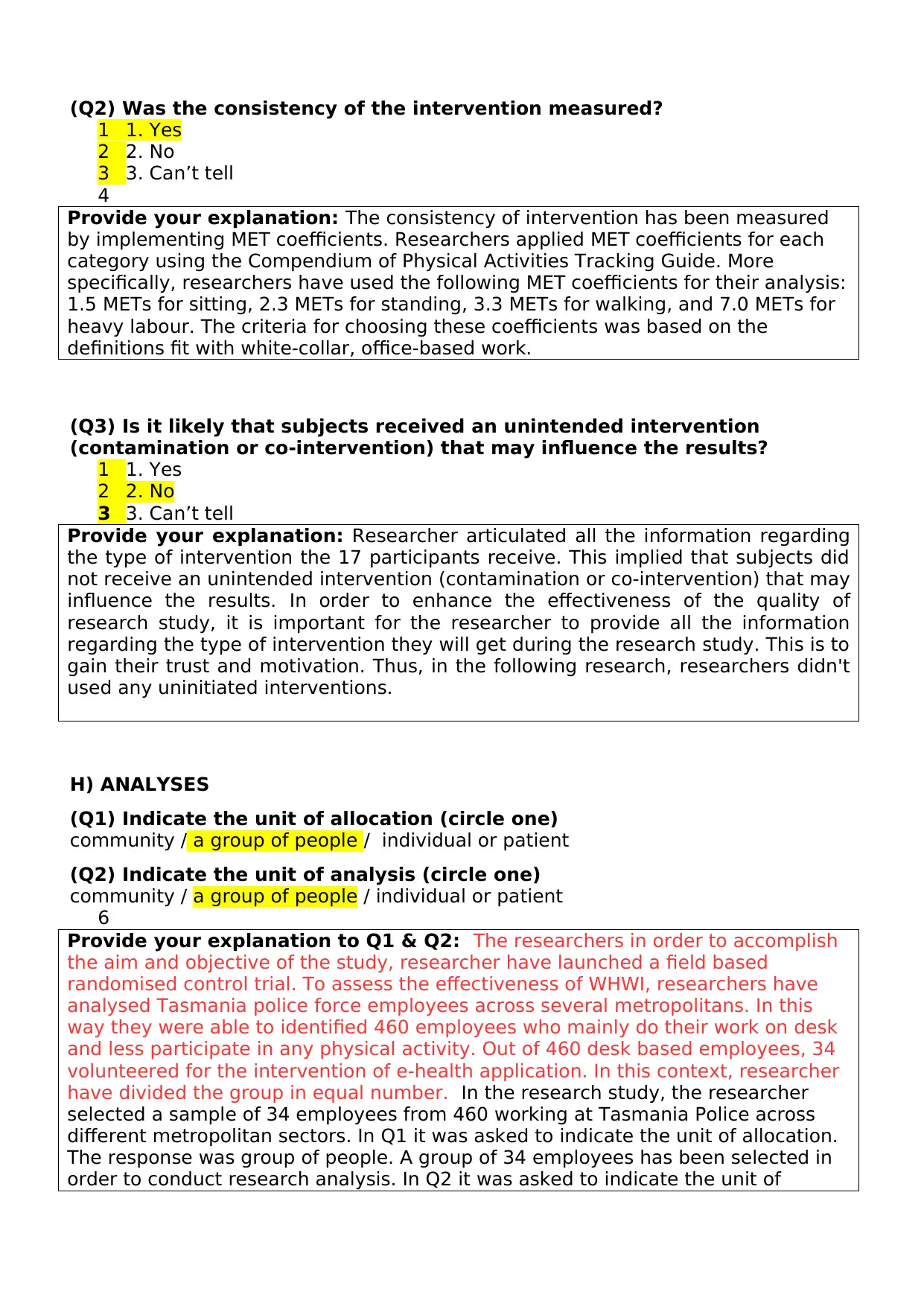
(Q2) Was the consistency of the intervention measured?
1 1. Yes
2 2. No
3 3. Can’t tell
4
Provide your explanation: The consistency of intervention has been measured
by implementing MET coefficients. Researchers applied MET coefficients for each
category using the Compendium of Physical Activities Tracking Guide. More
specifically, researchers have used the following MET coefficients for their analysis:
1.5 METs for sitting, 2.3 METs for standing, 3.3 METs for walking, and 7.0 METs for
heavy labour. The criteria for choosing these coefficients was based on the
definitions fit with white-collar, office-based work.
(Q3) Is it likely that subjects received an unintended intervention
(contamination or co-intervention) that may influence the results?
1 1. Yes
2 2. No
3 3. Can’t tell
Provide your explanation: Researcher articulated all the information regarding
the type of intervention the 17 participants receive. This implied that subjects did
not receive an unintended intervention (contamination or co-intervention) that may
influence the results. In order to enhance the effectiveness of the quality of
research study, it is important for the researcher to provide all the information
regarding the type of intervention they will get during the research study. This is to
gain their trust and motivation. Thus, in the following research, researchers didn't
used any uninitiated interventions.
H) ANALYSES
(Q1) Indicate the unit of allocation (circle one)
community / a group of people / individual or patient
(Q2) Indicate the unit of analysis (circle one)
community / a group of people / individual or patient
6
Provide your explanation to Q1 & Q2: The researchers in order to accomplish
the aim and objective of the study, researcher have launched a field based
randomised control trial. To assess the effectiveness of WHWI, researchers have
analysed Tasmania police force employees across several metropolitans. In this
way they were able to identified 460 employees who mainly do their work on desk
and less participate in any physical activity. Out of 460 desk based employees, 34
volunteered for the intervention of e-health application. In this context, researcher
have divided the group in equal number. In the research study, the researcher
selected a sample of 34 employees from 460 working at Tasmania Police across
different metropolitan sectors. In Q1 it was asked to indicate the unit of allocation.
The response was group of people. A group of 34 employees has been selected in
order to conduct research analysis. In Q2 it was asked to indicate the unit of
1 1. Yes
2 2. No
3 3. Can’t tell
4
Provide your explanation: The consistency of intervention has been measured
by implementing MET coefficients. Researchers applied MET coefficients for each
category using the Compendium of Physical Activities Tracking Guide. More
specifically, researchers have used the following MET coefficients for their analysis:
1.5 METs for sitting, 2.3 METs for standing, 3.3 METs for walking, and 7.0 METs for
heavy labour. The criteria for choosing these coefficients was based on the
definitions fit with white-collar, office-based work.
(Q3) Is it likely that subjects received an unintended intervention
(contamination or co-intervention) that may influence the results?
1 1. Yes
2 2. No
3 3. Can’t tell
Provide your explanation: Researcher articulated all the information regarding
the type of intervention the 17 participants receive. This implied that subjects did
not receive an unintended intervention (contamination or co-intervention) that may
influence the results. In order to enhance the effectiveness of the quality of
research study, it is important for the researcher to provide all the information
regarding the type of intervention they will get during the research study. This is to
gain their trust and motivation. Thus, in the following research, researchers didn't
used any uninitiated interventions.
H) ANALYSES
(Q1) Indicate the unit of allocation (circle one)
community / a group of people / individual or patient
(Q2) Indicate the unit of analysis (circle one)
community / a group of people / individual or patient
6
Provide your explanation to Q1 & Q2: The researchers in order to accomplish
the aim and objective of the study, researcher have launched a field based
randomised control trial. To assess the effectiveness of WHWI, researchers have
analysed Tasmania police force employees across several metropolitans. In this
way they were able to identified 460 employees who mainly do their work on desk
and less participate in any physical activity. Out of 460 desk based employees, 34
volunteered for the intervention of e-health application. In this context, researcher
have divided the group in equal number. In the research study, the researcher
selected a sample of 34 employees from 460 working at Tasmania Police across
different metropolitan sectors. In Q1 it was asked to indicate the unit of allocation.
The response was group of people. A group of 34 employees has been selected in
order to conduct research analysis. In Q2 it was asked to indicate the unit of
Secure Best Marks with AI Grader
Need help grading? Try our AI Grader for instant feedback on your assignments.
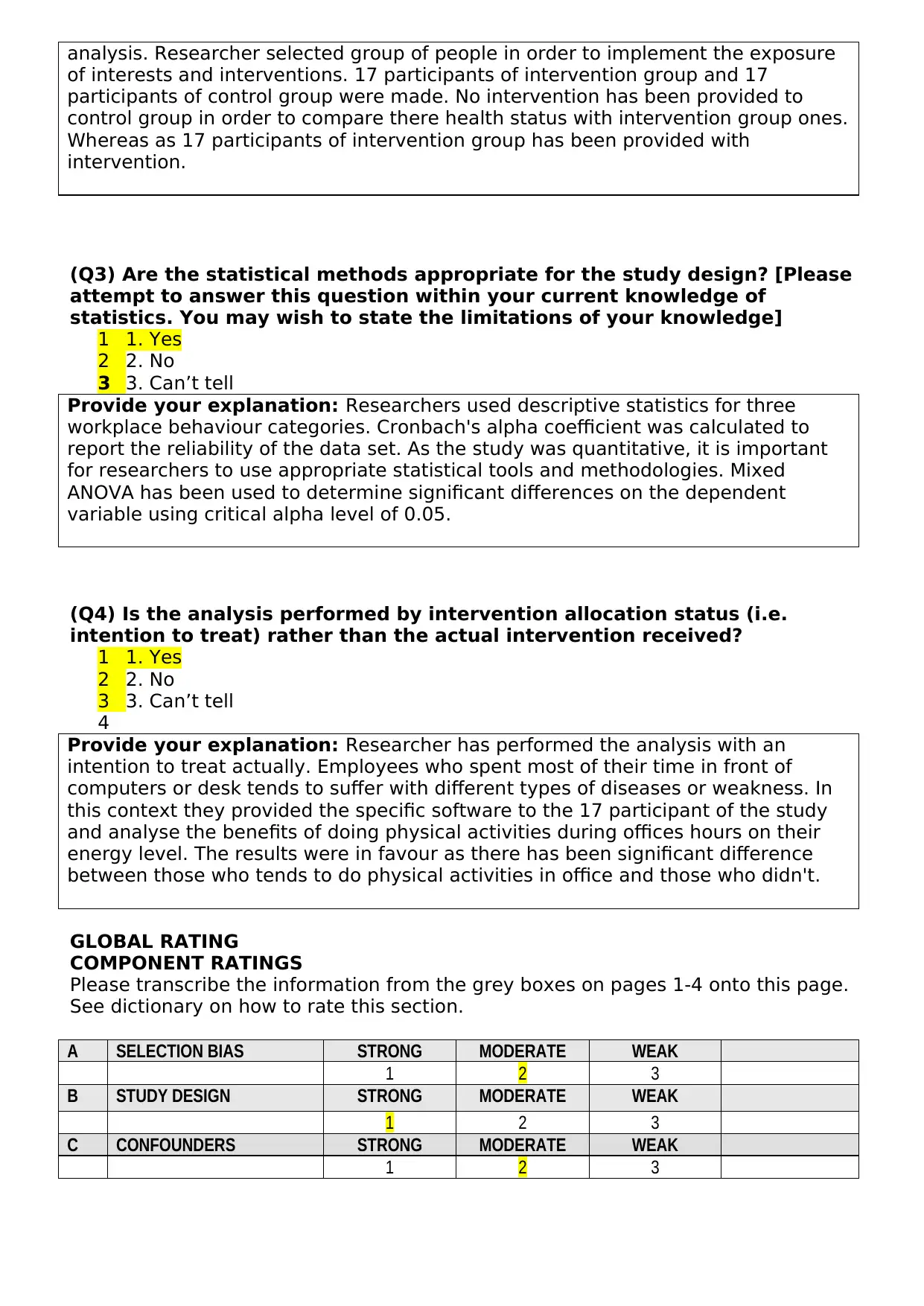
analysis. Researcher selected group of people in order to implement the exposure
of interests and interventions. 17 participants of intervention group and 17
participants of control group were made. No intervention has been provided to
control group in order to compare there health status with intervention group ones.
Whereas as 17 participants of intervention group has been provided with
intervention.
(Q3) Are the statistical methods appropriate for the study design? [Please
attempt to answer this question within your current knowledge of
statistics. You may wish to state the limitations of your knowledge]
1 1. Yes
2 2. No
3 3. Can’t tell
Provide your explanation: Researchers used descriptive statistics for three
workplace behaviour categories. Cronbach's alpha coefficient was calculated to
report the reliability of the data set. As the study was quantitative, it is important
for researchers to use appropriate statistical tools and methodologies. Mixed
ANOVA has been used to determine significant differences on the dependent
variable using critical alpha level of 0.05.
(Q4) Is the analysis performed by intervention allocation status (i.e.
intention to treat) rather than the actual intervention received?
1 1. Yes
2 2. No
3 3. Can’t tell
4
Provide your explanation: Researcher has performed the analysis with an
intention to treat actually. Employees who spent most of their time in front of
computers or desk tends to suffer with different types of diseases or weakness. In
this context they provided the specific software to the 17 participant of the study
and analyse the benefits of doing physical activities during offices hours on their
energy level. The results were in favour as there has been significant difference
between those who tends to do physical activities in office and those who didn't.
GLOBAL RATING
COMPONENT RATINGS
Please transcribe the information from the grey boxes on pages 1-4 onto this page.
See dictionary on how to rate this section.
A SELECTION BIAS STRONG MODERATE WEAK
1 2 3
B STUDY DESIGN STRONG MODERATE WEAK
1 2 3
C CONFOUNDERS STRONG MODERATE WEAK
1 2 3
of interests and interventions. 17 participants of intervention group and 17
participants of control group were made. No intervention has been provided to
control group in order to compare there health status with intervention group ones.
Whereas as 17 participants of intervention group has been provided with
intervention.
(Q3) Are the statistical methods appropriate for the study design? [Please
attempt to answer this question within your current knowledge of
statistics. You may wish to state the limitations of your knowledge]
1 1. Yes
2 2. No
3 3. Can’t tell
Provide your explanation: Researchers used descriptive statistics for three
workplace behaviour categories. Cronbach's alpha coefficient was calculated to
report the reliability of the data set. As the study was quantitative, it is important
for researchers to use appropriate statistical tools and methodologies. Mixed
ANOVA has been used to determine significant differences on the dependent
variable using critical alpha level of 0.05.
(Q4) Is the analysis performed by intervention allocation status (i.e.
intention to treat) rather than the actual intervention received?
1 1. Yes
2 2. No
3 3. Can’t tell
4
Provide your explanation: Researcher has performed the analysis with an
intention to treat actually. Employees who spent most of their time in front of
computers or desk tends to suffer with different types of diseases or weakness. In
this context they provided the specific software to the 17 participant of the study
and analyse the benefits of doing physical activities during offices hours on their
energy level. The results were in favour as there has been significant difference
between those who tends to do physical activities in office and those who didn't.
GLOBAL RATING
COMPONENT RATINGS
Please transcribe the information from the grey boxes on pages 1-4 onto this page.
See dictionary on how to rate this section.
A SELECTION BIAS STRONG MODERATE WEAK
1 2 3
B STUDY DESIGN STRONG MODERATE WEAK
1 2 3
C CONFOUNDERS STRONG MODERATE WEAK
1 2 3

D BLINDING STRONG MODERATE WEAK
1 2 3
E DATA COLLECTION
METHOD
STRONG MODERATE WEAK
1 2 3
F WITHDRAWALS AND
DROPOUTS
STRONG MODERATE WEAK
1 2 3 Not Applicable
CIISR.Ni92688
GLOBAL RATING FOR THIS PAPER (circle one):
1 STRONG (no WEAK ratings)
2 MODERATE (one WEAK rating)
3 WEAK (two or more WEAK ratings)
1 2 3
E DATA COLLECTION
METHOD
STRONG MODERATE WEAK
1 2 3
F WITHDRAWALS AND
DROPOUTS
STRONG MODERATE WEAK
1 2 3 Not Applicable
CIISR.Ni92688
GLOBAL RATING FOR THIS PAPER (circle one):
1 STRONG (no WEAK ratings)
2 MODERATE (one WEAK rating)
3 WEAK (two or more WEAK ratings)
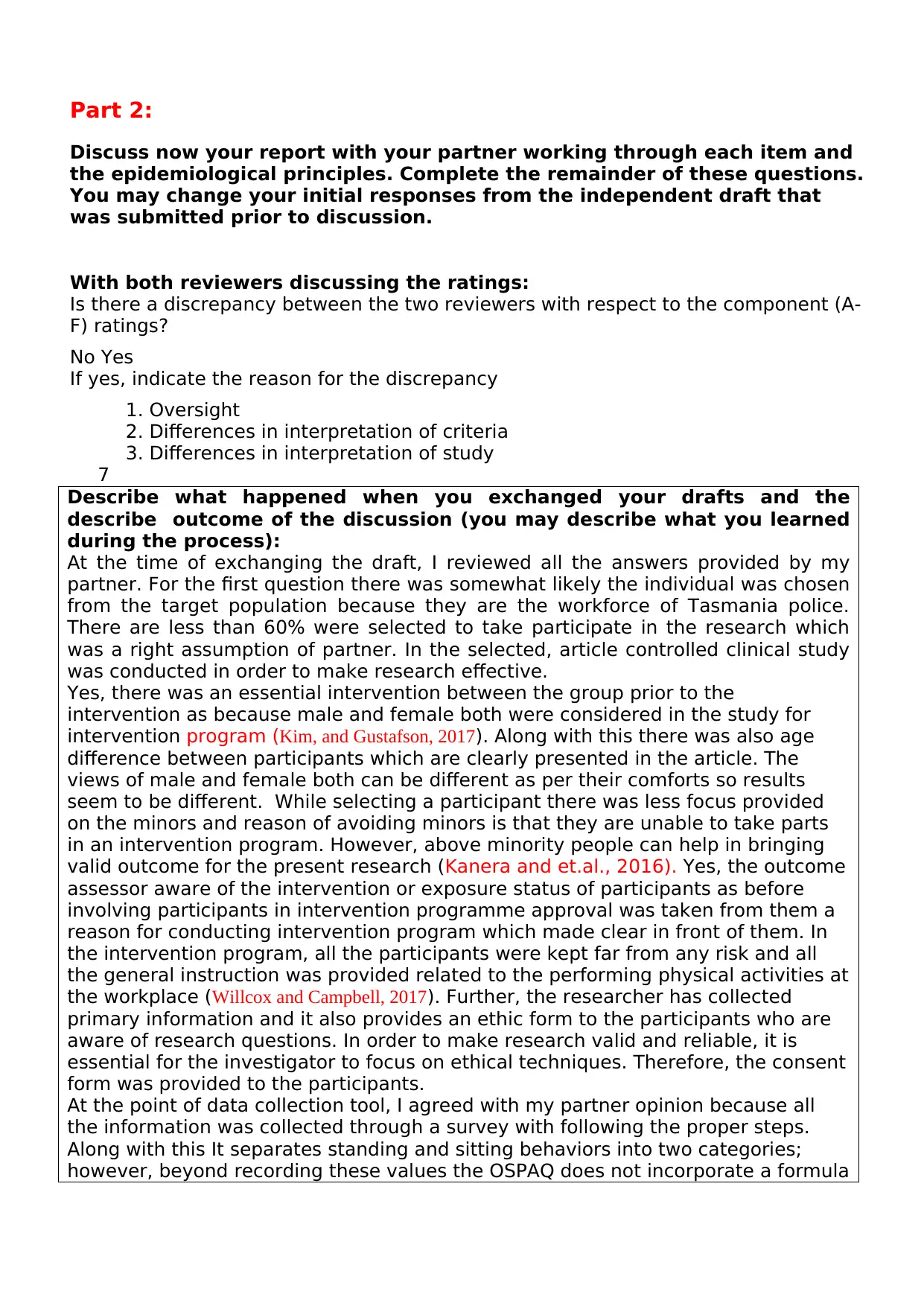
Part 2:
Discuss now your report with your partner working through each item and
the epidemiological principles. Complete the remainder of these questions.
You may change your initial responses from the independent draft that
was submitted prior to discussion.
With both reviewers discussing the ratings:
Is there a discrepancy between the two reviewers with respect to the component (A-
F) ratings?
No Yes
If yes, indicate the reason for the discrepancy
1. Oversight
2. Differences in interpretation of criteria
3. Differences in interpretation of study
7
Describe what happened when you exchanged your drafts and the
describe outcome of the discussion (you may describe what you learned
during the process):
At the time of exchanging the draft, I reviewed all the answers provided by my
partner. For the first question there was somewhat likely the individual was chosen
from the target population because they are the workforce of Tasmania police.
There are less than 60% were selected to take participate in the research which
was a right assumption of partner. In the selected, article controlled clinical study
was conducted in order to make research effective.
Yes, there was an essential intervention between the group prior to the
intervention as because male and female both were considered in the study for
intervention program (Kim, and Gustafson, 2017). Along with this there was also age
difference between participants which are clearly presented in the article. The
views of male and female both can be different as per their comforts so results
seem to be different. While selecting a participant there was less focus provided
on the minors and reason of avoiding minors is that they are unable to take parts
in an intervention program. However, above minority people can help in bringing
valid outcome for the present research (Kanera and et.al., 2016). Yes, the outcome
assessor aware of the intervention or exposure status of participants as before
involving participants in intervention programme approval was taken from them a
reason for conducting intervention program which made clear in front of them. In
the intervention program, all the participants were kept far from any risk and all
the general instruction was provided related to the performing physical activities at
the workplace (Willcox and Campbell, 2017). Further, the researcher has collected
primary information and it also provides an ethic form to the participants who are
aware of research questions. In order to make research valid and reliable, it is
essential for the investigator to focus on ethical techniques. Therefore, the consent
form was provided to the participants.
At the point of data collection tool, I agreed with my partner opinion because all
the information was collected through a survey with following the proper steps.
Along with this It separates standing and sitting behaviors into two categories;
however, beyond recording these values the OSPAQ does not incorporate a formula
Discuss now your report with your partner working through each item and
the epidemiological principles. Complete the remainder of these questions.
You may change your initial responses from the independent draft that
was submitted prior to discussion.
With both reviewers discussing the ratings:
Is there a discrepancy between the two reviewers with respect to the component (A-
F) ratings?
No Yes
If yes, indicate the reason for the discrepancy
1. Oversight
2. Differences in interpretation of criteria
3. Differences in interpretation of study
7
Describe what happened when you exchanged your drafts and the
describe outcome of the discussion (you may describe what you learned
during the process):
At the time of exchanging the draft, I reviewed all the answers provided by my
partner. For the first question there was somewhat likely the individual was chosen
from the target population because they are the workforce of Tasmania police.
There are less than 60% were selected to take participate in the research which
was a right assumption of partner. In the selected, article controlled clinical study
was conducted in order to make research effective.
Yes, there was an essential intervention between the group prior to the
intervention as because male and female both were considered in the study for
intervention program (Kim, and Gustafson, 2017). Along with this there was also age
difference between participants which are clearly presented in the article. The
views of male and female both can be different as per their comforts so results
seem to be different. While selecting a participant there was less focus provided
on the minors and reason of avoiding minors is that they are unable to take parts
in an intervention program. However, above minority people can help in bringing
valid outcome for the present research (Kanera and et.al., 2016). Yes, the outcome
assessor aware of the intervention or exposure status of participants as before
involving participants in intervention programme approval was taken from them a
reason for conducting intervention program which made clear in front of them. In
the intervention program, all the participants were kept far from any risk and all
the general instruction was provided related to the performing physical activities at
the workplace (Willcox and Campbell, 2017). Further, the researcher has collected
primary information and it also provides an ethic form to the participants who are
aware of research questions. In order to make research valid and reliable, it is
essential for the investigator to focus on ethical techniques. Therefore, the consent
form was provided to the participants.
At the point of data collection tool, I agreed with my partner opinion because all
the information was collected through a survey with following the proper steps.
Along with this It separates standing and sitting behaviors into two categories;
however, beyond recording these values the OSPAQ does not incorporate a formula
Paraphrase This Document
Need a fresh take? Get an instant paraphrase of this document with our AI Paraphraser
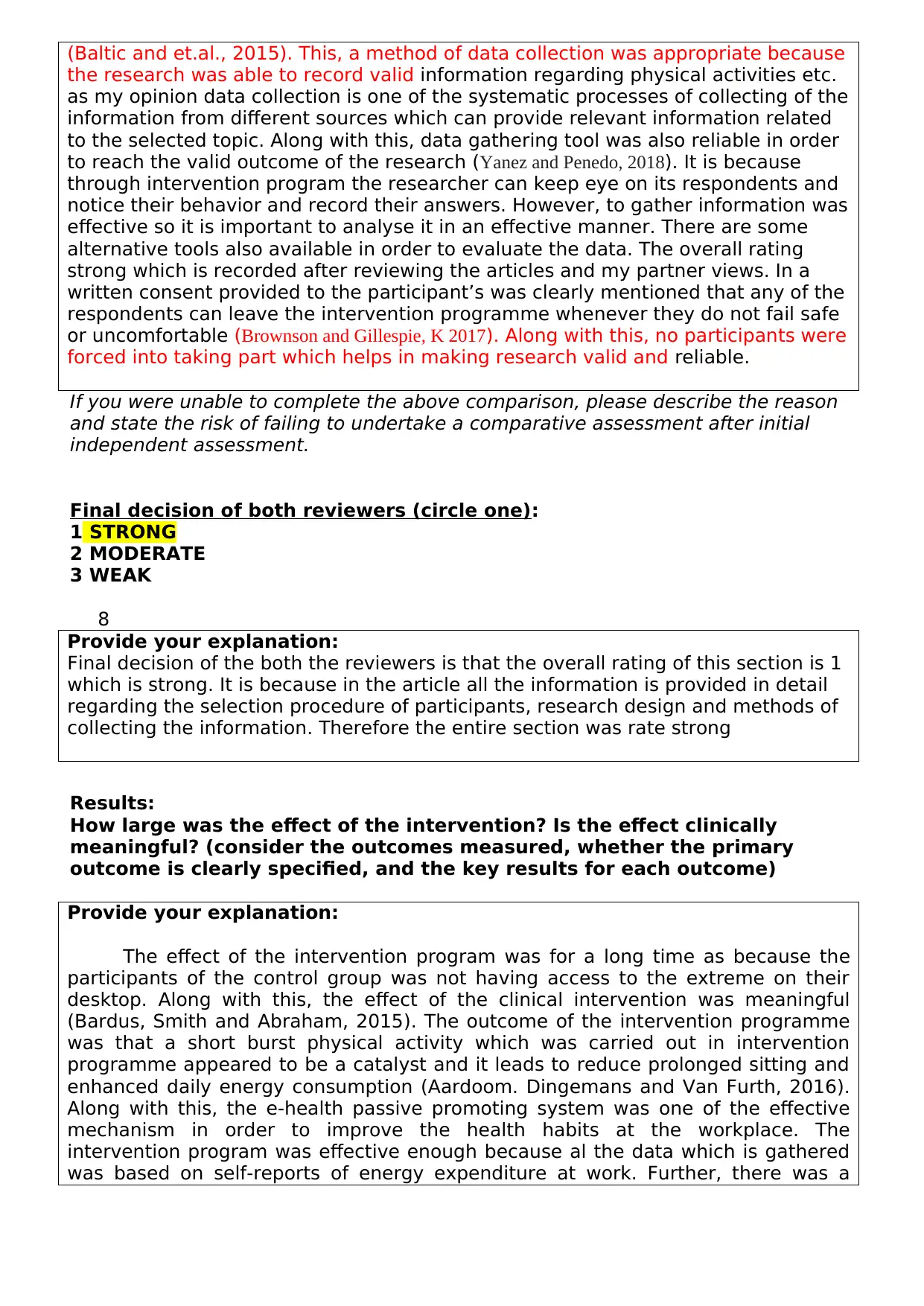
(Baltic and et.al., 2015). This, a method of data collection was appropriate because
the research was able to record valid information regarding physical activities etc.
as my opinion data collection is one of the systematic processes of collecting of the
information from different sources which can provide relevant information related
to the selected topic. Along with this, data gathering tool was also reliable in order
to reach the valid outcome of the research (Yanez and Penedo, 2018). It is because
through intervention program the researcher can keep eye on its respondents and
notice their behavior and record their answers. However, to gather information was
effective so it is important to analyse it in an effective manner. There are some
alternative tools also available in order to evaluate the data. The overall rating
strong which is recorded after reviewing the articles and my partner views. In a
written consent provided to the participant’s was clearly mentioned that any of the
respondents can leave the intervention programme whenever they do not fail safe
or uncomfortable (Brownson and Gillespie, K 2017). Along with this, no participants were
forced into taking part which helps in making research valid and reliable.
If you were unable to complete the above comparison, please describe the reason
and state the risk of failing to undertake a comparative assessment after initial
independent assessment.
Final decision of both reviewers (circle one):
1 STRONG
2 MODERATE
3 WEAK
8
Provide your explanation:
Final decision of the both the reviewers is that the overall rating of this section is 1
which is strong. It is because in the article all the information is provided in detail
regarding the selection procedure of participants, research design and methods of
collecting the information. Therefore the entire section was rate strong
Results:
How large was the effect of the intervention? Is the effect clinically
meaningful? (consider the outcomes measured, whether the primary
outcome is clearly specified, and the key results for each outcome)
Provide your explanation:
The effect of the intervention program was for a long time as because the
participants of the control group was not having access to the extreme on their
desktop. Along with this, the effect of the clinical intervention was meaningful
(Bardus, Smith and Abraham, 2015). The outcome of the intervention programme
was that a short burst physical activity which was carried out in intervention
programme appeared to be a catalyst and it leads to reduce prolonged sitting and
enhanced daily energy consumption (Aardoom. Dingemans and Van Furth, 2016).
Along with this, the e-health passive promoting system was one of the effective
mechanism in order to improve the health habits at the workplace. The
intervention program was effective enough because al the data which is gathered
was based on self-reports of energy expenditure at work. Further, there was a
the research was able to record valid information regarding physical activities etc.
as my opinion data collection is one of the systematic processes of collecting of the
information from different sources which can provide relevant information related
to the selected topic. Along with this, data gathering tool was also reliable in order
to reach the valid outcome of the research (Yanez and Penedo, 2018). It is because
through intervention program the researcher can keep eye on its respondents and
notice their behavior and record their answers. However, to gather information was
effective so it is important to analyse it in an effective manner. There are some
alternative tools also available in order to evaluate the data. The overall rating
strong which is recorded after reviewing the articles and my partner views. In a
written consent provided to the participant’s was clearly mentioned that any of the
respondents can leave the intervention programme whenever they do not fail safe
or uncomfortable (Brownson and Gillespie, K 2017). Along with this, no participants were
forced into taking part which helps in making research valid and reliable.
If you were unable to complete the above comparison, please describe the reason
and state the risk of failing to undertake a comparative assessment after initial
independent assessment.
Final decision of both reviewers (circle one):
1 STRONG
2 MODERATE
3 WEAK
8
Provide your explanation:
Final decision of the both the reviewers is that the overall rating of this section is 1
which is strong. It is because in the article all the information is provided in detail
regarding the selection procedure of participants, research design and methods of
collecting the information. Therefore the entire section was rate strong
Results:
How large was the effect of the intervention? Is the effect clinically
meaningful? (consider the outcomes measured, whether the primary
outcome is clearly specified, and the key results for each outcome)
Provide your explanation:
The effect of the intervention program was for a long time as because the
participants of the control group was not having access to the extreme on their
desktop. Along with this, the effect of the clinical intervention was meaningful
(Bardus, Smith and Abraham, 2015). The outcome of the intervention programme
was that a short burst physical activity which was carried out in intervention
programme appeared to be a catalyst and it leads to reduce prolonged sitting and
enhanced daily energy consumption (Aardoom. Dingemans and Van Furth, 2016).
Along with this, the e-health passive promoting system was one of the effective
mechanism in order to improve the health habits at the workplace. The
intervention program was effective enough because al the data which is gathered
was based on self-reports of energy expenditure at work. Further, there was a
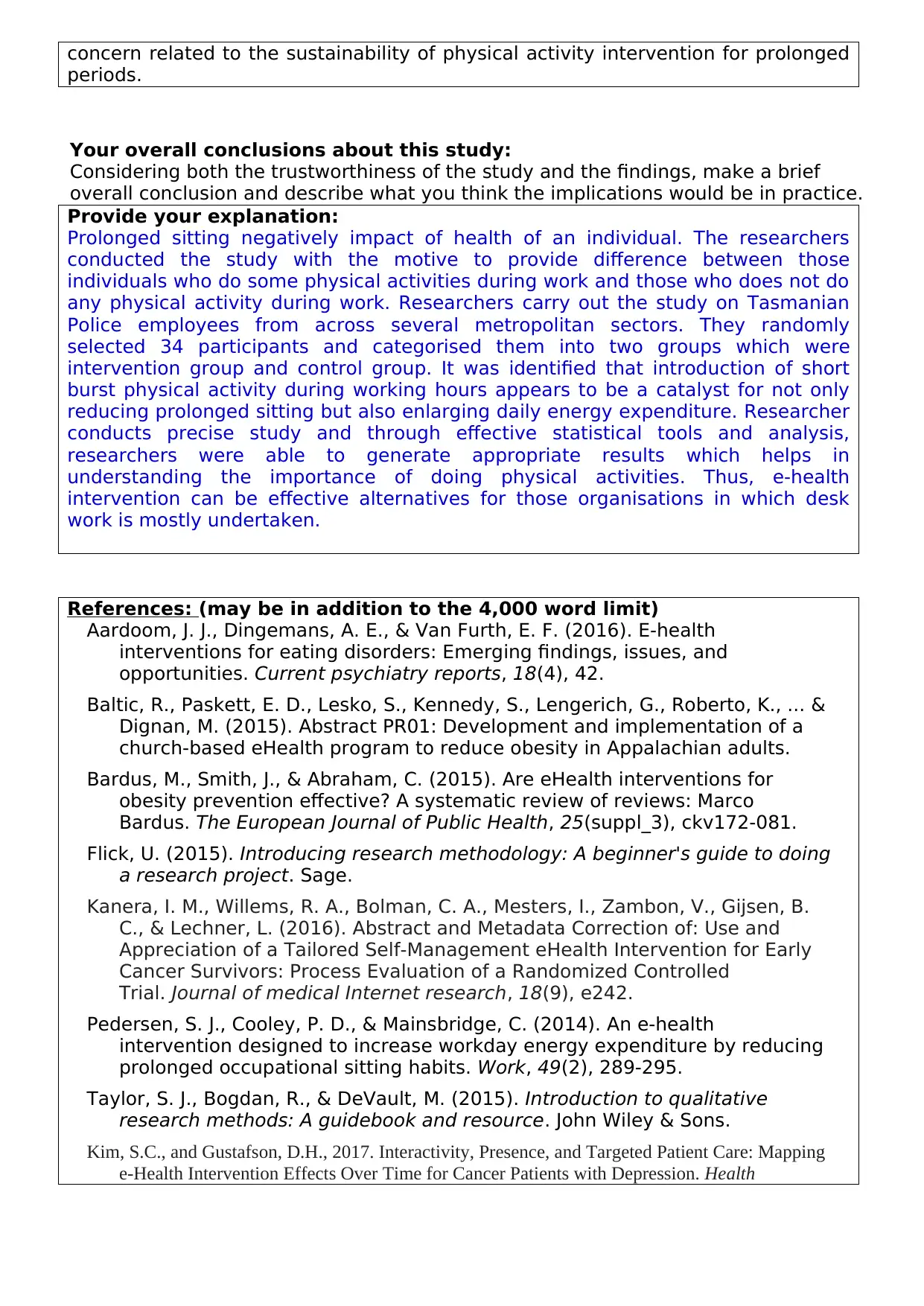
concern related to the sustainability of physical activity intervention for prolonged
periods.
Your overall conclusions about this study:
Considering both the trustworthiness of the study and the findings, make a brief
overall conclusion and describe what you think the implications would be in practice.
Provide your explanation:
Prolonged sitting negatively impact of health of an individual. The researchers
conducted the study with the motive to provide difference between those
individuals who do some physical activities during work and those who does not do
any physical activity during work. Researchers carry out the study on Tasmanian
Police employees from across several metropolitan sectors. They randomly
selected 34 participants and categorised them into two groups which were
intervention group and control group. It was identified that introduction of short
burst physical activity during working hours appears to be a catalyst for not only
reducing prolonged sitting but also enlarging daily energy expenditure. Researcher
conducts precise study and through effective statistical tools and analysis,
researchers were able to generate appropriate results which helps in
understanding the importance of doing physical activities. Thus, e-health
intervention can be effective alternatives for those organisations in which desk
work is mostly undertaken.
References: (may be in addition to the 4,000 word limit)
Aardoom, J. J., Dingemans, A. E., & Van Furth, E. F. (2016). E-health
interventions for eating disorders: Emerging findings, issues, and
opportunities. Current psychiatry reports, 18(4), 42.
Baltic, R., Paskett, E. D., Lesko, S., Kennedy, S., Lengerich, G., Roberto, K., ... &
Dignan, M. (2015). Abstract PR01: Development and implementation of a
church-based eHealth program to reduce obesity in Appalachian adults.
Bardus, M., Smith, J., & Abraham, C. (2015). Are eHealth interventions for
obesity prevention effective? A systematic review of reviews: Marco
Bardus. The European Journal of Public Health, 25(suppl_3), ckv172-081.
Flick, U. (2015). Introducing research methodology: A beginner's guide to doing
a research project. Sage.
Kanera, I. M., Willems, R. A., Bolman, C. A., Mesters, I., Zambon, V., Gijsen, B.
C., & Lechner, L. (2016). Abstract and Metadata Correction of: Use and
Appreciation of a Tailored Self-Management eHealth Intervention for Early
Cancer Survivors: Process Evaluation of a Randomized Controlled
Trial. Journal of medical Internet research, 18(9), e242.
Pedersen, S. J., Cooley, P. D., & Mainsbridge, C. (2014). An e-health
intervention designed to increase workday energy expenditure by reducing
prolonged occupational sitting habits. Work, 49(2), 289-295.
Taylor, S. J., Bogdan, R., & DeVault, M. (2015). Introduction to qualitative
research methods: A guidebook and resource. John Wiley & Sons.
Kim, S.C., and Gustafson, D.H., 2017. Interactivity, Presence, and Targeted Patient Care: Mapping
e-Health Intervention Effects Over Time for Cancer Patients with Depression. Health
periods.
Your overall conclusions about this study:
Considering both the trustworthiness of the study and the findings, make a brief
overall conclusion and describe what you think the implications would be in practice.
Provide your explanation:
Prolonged sitting negatively impact of health of an individual. The researchers
conducted the study with the motive to provide difference between those
individuals who do some physical activities during work and those who does not do
any physical activity during work. Researchers carry out the study on Tasmanian
Police employees from across several metropolitan sectors. They randomly
selected 34 participants and categorised them into two groups which were
intervention group and control group. It was identified that introduction of short
burst physical activity during working hours appears to be a catalyst for not only
reducing prolonged sitting but also enlarging daily energy expenditure. Researcher
conducts precise study and through effective statistical tools and analysis,
researchers were able to generate appropriate results which helps in
understanding the importance of doing physical activities. Thus, e-health
intervention can be effective alternatives for those organisations in which desk
work is mostly undertaken.
References: (may be in addition to the 4,000 word limit)
Aardoom, J. J., Dingemans, A. E., & Van Furth, E. F. (2016). E-health
interventions for eating disorders: Emerging findings, issues, and
opportunities. Current psychiatry reports, 18(4), 42.
Baltic, R., Paskett, E. D., Lesko, S., Kennedy, S., Lengerich, G., Roberto, K., ... &
Dignan, M. (2015). Abstract PR01: Development and implementation of a
church-based eHealth program to reduce obesity in Appalachian adults.
Bardus, M., Smith, J., & Abraham, C. (2015). Are eHealth interventions for
obesity prevention effective? A systematic review of reviews: Marco
Bardus. The European Journal of Public Health, 25(suppl_3), ckv172-081.
Flick, U. (2015). Introducing research methodology: A beginner's guide to doing
a research project. Sage.
Kanera, I. M., Willems, R. A., Bolman, C. A., Mesters, I., Zambon, V., Gijsen, B.
C., & Lechner, L. (2016). Abstract and Metadata Correction of: Use and
Appreciation of a Tailored Self-Management eHealth Intervention for Early
Cancer Survivors: Process Evaluation of a Randomized Controlled
Trial. Journal of medical Internet research, 18(9), e242.
Pedersen, S. J., Cooley, P. D., & Mainsbridge, C. (2014). An e-health
intervention designed to increase workday energy expenditure by reducing
prolonged occupational sitting habits. Work, 49(2), 289-295.
Taylor, S. J., Bogdan, R., & DeVault, M. (2015). Introduction to qualitative
research methods: A guidebook and resource. John Wiley & Sons.
Kim, S.C., and Gustafson, D.H., 2017. Interactivity, Presence, and Targeted Patient Care: Mapping
e-Health Intervention Effects Over Time for Cancer Patients with Depression. Health
1 out of 15
Related Documents
Your All-in-One AI-Powered Toolkit for Academic Success.
+13062052269
info@desklib.com
Available 24*7 on WhatsApp / Email
![[object Object]](/_next/static/media/star-bottom.7253800d.svg)
Unlock your academic potential
© 2024 | Zucol Services PVT LTD | All rights reserved.




